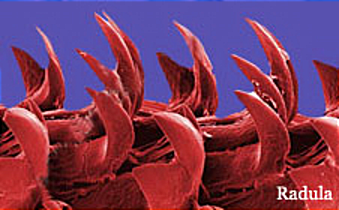How the radula works
To
the right is an overview diagram of the major parts of a snail's feeding
anatomy. Although very complex, every effort will be made to
explain how it works in (almost) everyday language.
More detailed information on specific terms can be obtained by clicking on hyperlinks (e.g. hyperlink)
Some snails are herbivores and eat algae and vegetation. others are carnivorous and feed upon other animals including snails.
Food is taken into the mouth by organs in the buccal cavity, which includes the radula and then passed along to the esophagus.
Some marine snails scrape algae and other plant matter from surfaces in the bay bottom, but other have adapted to boring (drilling) holes in shellfish to consume the meat of their victims.
Two examples of boring snails are moon snails and oyster drills.
When not feeding
Taking a closer look at the snail's feeding mechanisms, we see that inside the mouth is a chamber called the radular sac.
When not feeding the radula is retracted into this chamber which protects the mouth from the sharp teeth of the radula.
The radula is a ribbon-like structure which has hundreds to thousands of backwardly pointing chitinous teeth. The radula slides over a supporting structure of cartilage called the odontophore.
Both the radula and the odontophore can be moved forward (protracted) out of the mouth for feeding and brought back in (retracted) to bring in food or when finished eating.
This movement is accomplished by sets of protractor and retractor muscles as seen in the diagram to the right.
When a food source is located, the snail will begin to feed by first opening its mouth. The protractor muscles move the odontophore forward and the radula comes in contact with the food.
The retractor muscle sets bring the odontophore and the radula backwards and the teeth scrape the surface. Food particles are moved up into the mouth as it closes.
This process is repeated as the snail continues to feed.
The image below is a hard clam that been a victim of a boring snail. This is typical of moon snail predation.
Two microscopic images of radula
Radulae shapes and sizes differ with each species of gastropod, but in essence they do the same function and are composed of the same material.
Boring snails that drill into shells have the process further assisted by secretions of an accessory salivary gland. These secretions are acidic and help to soften shell materials.


The image to the left shows a microscopic view of the curved denticle (teeth) on a radula.
The image to the right shows an array of teeth on the radula of an Oyster Drill.
The left and right ranks of teeth are hooked, and the middle tooth shows three cusps.
Like all gastropods, the radular teeth are continually renewed from top to bottom, as they are worn away.